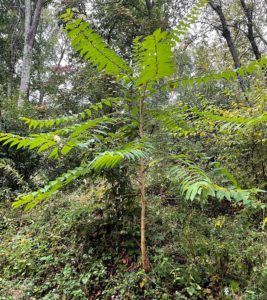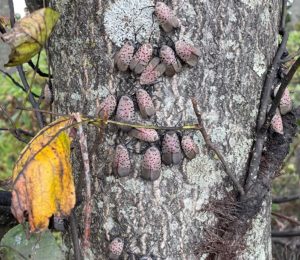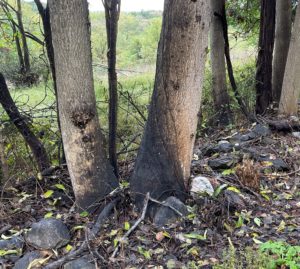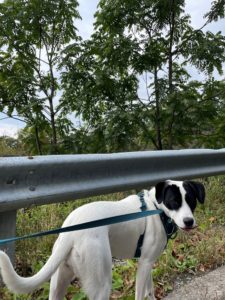Hello fellow readers, Jolee and I pass a mature stand of Tree of Heaven on our morning walks. There’s been a sickening smell of rotting apples for weeks now, and the trunks are loaded with Spotted Lanternflies. And I ask myself, why is it called Tree of Heaven?
Spotted Lanterfly’s preferred host
It’s interesting that while the invasive planthoppers arrived unintentionally, their desired host plant, the Tree of Heaven, came deliberately, first in the late 1700s and were admired for decades. It’s the tree featured in the classic novel A Tree Grows in Brooklyn.
Spottedlantern Fly native to China, India, and Vietnam, came here as egg masses on imported stone. The first infestation was in Berks County, PA, in 2014 in a forest of primarily Tree of Heaven (Ailanthus altissima), also from China and Taiwan.
Why is it called the Tree of Heaven?
They were considered a favorable and ornamental shade tree that quickly grew to eighty feet and were planted extensively in Washington DC and New York City. The bark is a smooth greenish-brown when young, then matures to brownish-grey with the texture of cantaloupe skin.
It spreads rapidly by seed and root suckers that can emerge as far as fifty feet from a parent tree. Plus, like black walnut, they produce chemicals that inhibit or prevent other plants from growing. It thrives in harsh conditions and crowds out native plants. By the early 1900s, Tree of Heaven lost its favor due to its invasive nature and odor when you crush the leaves or break stems.
So why, if a tree is problematic, is it called the Tree of Heaven? They say it earned the name because it grows ambitiously, reaching for the sky, and people admired its tenacity and ornamental, almost tropical appearance.
The smell of fermenting apples
It turns out the sickening smell from the Tree of Heaven is the fermenting sap caused by Spotted Lanternfly’s feeding damage leaving dark streaks down the trunks. Then there’s the sugary, sticky liquid they secrete called honeydew, attracting bees and wasps—the honeydew now covered with black mold.
Half of our alien insects are significant pests.
In a recent industry Plant Symposium, Steven Rettke, an Agriculture & Natural Resources Program Associate of Rutgers University, said, “two percent of our insects come from other countries, but nearly fifty percent of them are major pests.”
Just as with the Emerald Ash Borer, despite quarantine efforts, Spotted Lanternfly is spreading quickly. We spoke about how the Emerald Ash Borer became uncontrollable and unstoppable; then, authorities dropped the regulations. Once all the ash trees die, will the invasive insect die too? Or will they adapt or genetically modify, allowing them to find new sources of food. I’d bet the latter. It’s how the biology of pests and disease works.
Tree of Heaven Look-alikes
 The Tree of Heaven looks much like Sumac Trees, also aggressive spreaders, and Black Walnut and Hickory. But these native trees all have serrated edged leaves while the Tree of Heaven’s is smooth. And the native look-alikes don’t emit a foul smell.
The Tree of Heaven looks much like Sumac Trees, also aggressive spreaders, and Black Walnut and Hickory. But these native trees all have serrated edged leaves while the Tree of Heaven’s is smooth. And the native look-alikes don’t emit a foul smell.
A side note here is that Poison Sumac (Toxicodendron vernix) can cause a rash like poison ivy. And there are non-poisonous ones such as Staghorn Sumac (Rhus typhina), typical in the northeast, admired for their brilliant orange and red fall color.
Poison Sumacs live only in very wet areas and often as a single plant. In contrast, Staghorn Sumacs often colonize in dry conditions. Another way to tell them apart is Poison Sumac has smooth twigs while Staghorn Sumac is fuzzy.
A Tree Grows in Brooklyn features the Tree of Heaven.
It’s been years since I’ve read A Tree Grows in Brooklyn, the classic semi-autobiographical novel written by Betty Smith in 1943 about an ambitious teenage girl and her family in the inner city. Though poor, the family finds joy in life, satisfying their basic needs.
The Tree of Heaven grows in the tiniest cracks of sidewalks, fighting for the sun and air necessary to survive like the poor occupants of Brooklyn at the time. The tree is a metaphor for the girl’s drive to better herself – to move beyond poverty.
Perseverance through hardship; a theme much like the American Dream at the time of the novel and a dream that I pray remains today.
Garden Dilemmas? AskMaryStone@gmail.com (and your favorite Podcast App.)
Click through to Tree of Heaven: An Exotic Invasive Plant Fact Sheet which includes Integrated Pest Management (IPM) Strategies to remove them.
You’ll enjoy a previous story based on a children’s book – The Magic of Seeds.
Overcoming Fear – Jolee is demonstrating her stubbornness. The “terrible twos,” I coin it, though she’s just over a year per her rescue paperwork. When she doesn’t want to move forward, the brakes are on. Our dear girl still has a fear of new places—no doubt from her transport from the streets of Biloxi Missippi.
When she first came, we couldn’t get her to go beyond the driveway, and we’d lift her and carry her for a while. Back in the ground, she’d walk a bit more, each day slightly farther.
And here we are, eight months later, not yet successfully encouraging her to try a different route. I can still lift her, though she’s close to fifty pounds; But I can’t carry her as far (smile).
There’s a lesson in Jolee’s fear – that while overcoming it may take time, patience and understanding of the origin of fear is the first step in overcoming it.







Thanks for your info on the Ailanthes, which I call “the tree from hell.” I have one on the edge of my property which is 80 feet tall and has spawned seedlings all over. But with the cost of felling trees on our property, (we have over 20 Green Ash along the Paulinskill River) this one will have to wait. Tip for your readers, pull up the seedlings while they are young. The roots get more dug in the longer you wait!
Hello April, The darn things sucker and seed. Thanks for the tip and for reading my column. So sad about the ash trees… Mary